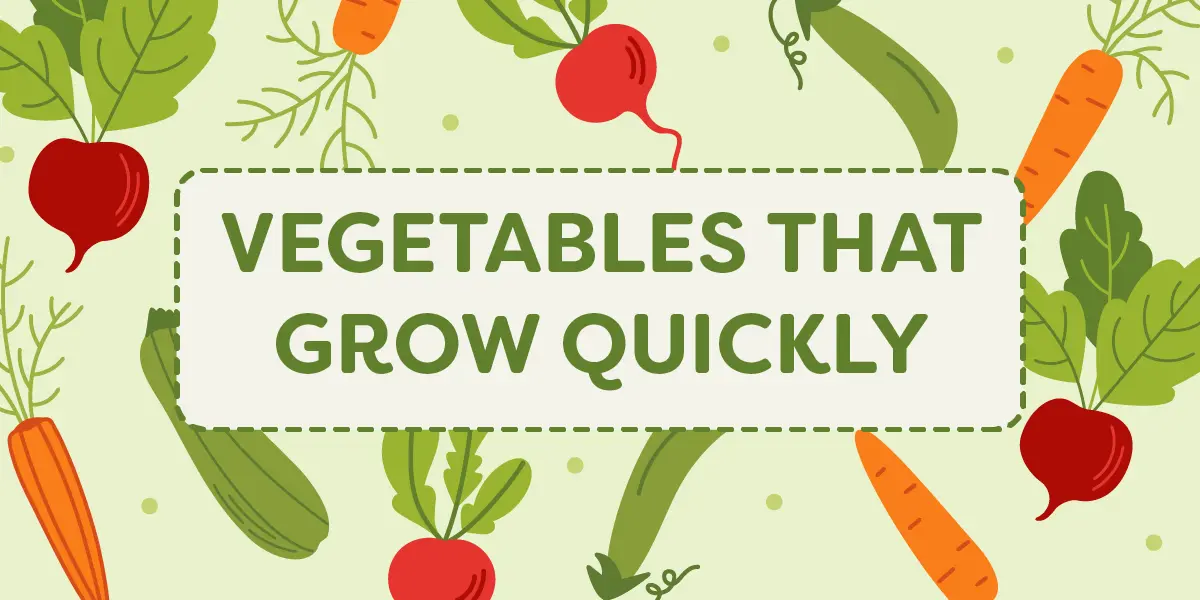We live in an impatient culture.
Fast food, fast service, instant messaging, on-demand streaming — we want it all now.
Sadly, the words “fast” and “garden” rarely go together unless they’re in the title of this blog.
Gardening takes time, effort, and patience. It’s the complete opposite of a trip to the store where, in minutes, you can load up on two weeks’ worth of produce, half of which will go bad before it reaches your table.
But the rewards of growing your own food are legion. And with a bit of forethought and elbow grease, you can cultivate fast-growing vegetables that will yield multiple harvests of delicious, nutritious produce all year.
Why Choose Fast-Growing Vegetables?
Beyond more immediate gratification, fast-growing vegetables have practical benefits. Here’s why you might want to focus on speedy greens:
- Faster growth means you can plant multiple crops in a single season.
- Fresh produce arrives on your plate sooner and more often.
- Fast harvests free up garden space for other plants.
- Shorter growth periods are less hospitable to pests.
Perfect for Beginners
Seeing rapid results can be incredibly motivating for novices. And, if you make a mistake with one crop, it’s no problem — try again with the next.
Perfect for Urban Gardens
Fast-growing vegetables can maximize your garden space and yield. These plants are ideal for containers that can fit in a limited area, like a porch or balcony.
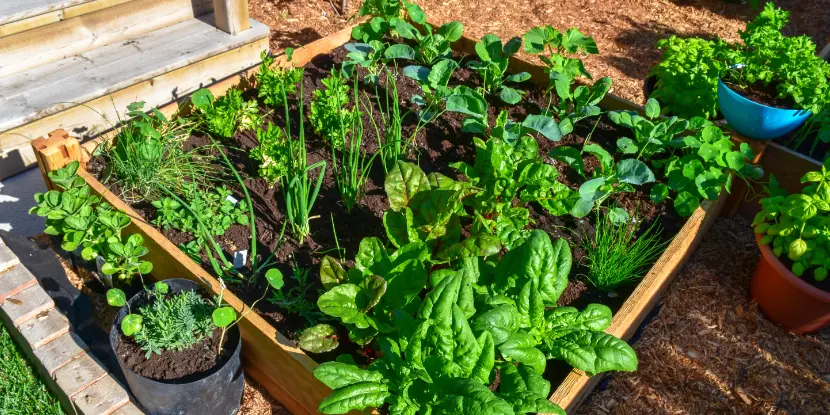
A small family garden with leafy greens.
What Makes a Vegetable Fast-Growing?
Factors in Growth Rate
- Vegetables flourish in specific temperature and humidity ranges. Southern California’s warm climate is favorable for many fast-growing vegetables.
- Rich, well-drained soil enhances nutrient uptake, promoting quicker growth.
- Consistent and appropriate watering is crucial to prevent stress and ensure rapid growth.
- Most fast-growing vegetables need full sun to photosynthesize efficiently.
- Properly spacing your plants allows for adequate air circulation and root expansion.
- Fertilizers provide essential nutrients that might be lacking in the soil.
Attributes of Fast-Growing Vegetables
- Fast-growing vegetables have short maturity periods and are ready to harvest in a few weeks to a couple of months.
- They can grow in varying conditions and are less susceptible to soil and weather changes.
- Seeds of fast-growing vegetables typically sprout quickly and reliably.
- Fast-growing plants exhibit robust growth that requires minimal intervention.
- Many fast-growing vegetables are bred to resist common diseases and pests, further ensuring successful and quick harvests.
Our Top 12 Fast-Growing Vegetables
This list is by no means exclusive or comprehensive, but it’s a great starting point for your Southern California garden.
1. Radishes
Radishes are the sprinters of the vegetable world, ready to harvest in as little as 3–4 weeks.
- Best Varieties: Cherry Belle, French Breakfast.
- Planting Tips: Plant seeds directly in the soil about 1/2 inch deep and an inch apart.
- Climate Suitability: Prefer cooler weather but can handle the warmth of early summer.
- Time to Harvest: 3–4 weeks.
- Special Notes: Radishes are easy to grow, but can become bitter if left in the ground too long. Harvest when they’re about an inch in diameter.
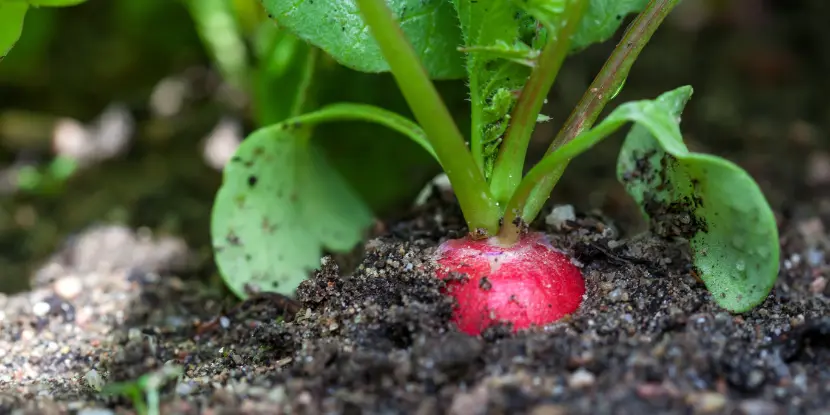
Radishes are the speed merchants of the vegetable world, ready to harvest in as little as 3 to 4 weeks.
2. Lettuce & Leafy Greens
Lettuce and other leafy greens, like spinach, arugula, and kale, are excellent choices because they can be continuously harvested as they grow.
- Best Varieties: Buttercrunch lettuce, Bloomsdale spinach, Red Russian kale.
- Planting Tips: Sow seeds directly in well-drained soil and keep them moist until germination.
- Climate Suitability: Prefers cooler weather but can tolerate mild heat.
- Time to Harvest: 3–4 weeks for baby greens, 6–8 weeks for full-size heads.
- Special Notes: Regularly pick outer leaves to encourage continuous growth.
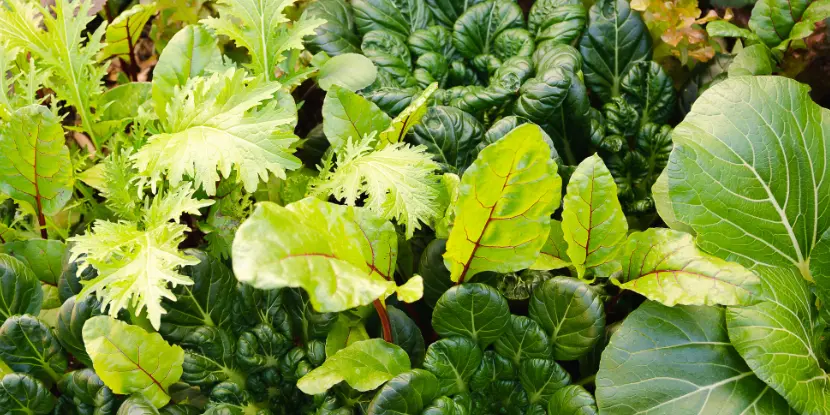
Leafy greens in the garden. All grow fast!
3. Cucumbers
With proper care, cucumbers grow like crazy and generate an abundant crop.
- Best Varieties: Straight Eight, Lemon, Marketmore.
- Planting Tips: Sow seeds in well-drained soil with plenty of organic matter. Provide support for vines to climb.
- Climate Suitability: Thrives in warm weather and full sun.
- Time to Harvest: 2–3 months.
- Special Notes: Pick cucumbers when fully grown but before they turn yellow.
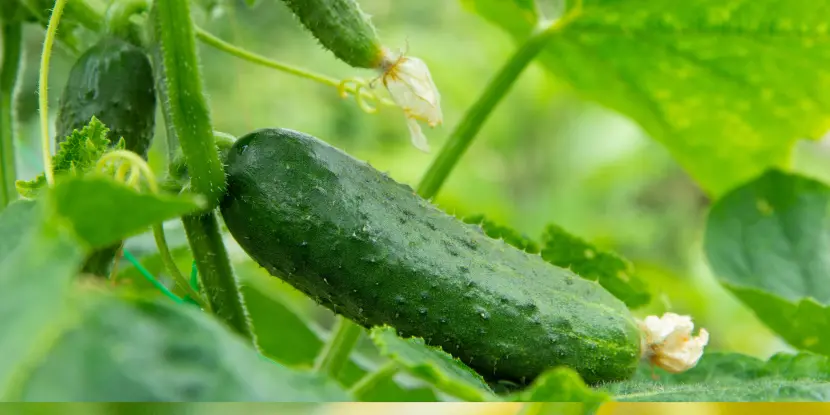
All varieties of cucumber are fast growers. Support them with a trellis or cage.
4. Green Beans & Peas
Fast-growing green beans produce multiple harvests throughout the season.
- Best Varieties: Blue Lake, Kentucky Wonder.
- Planting Tips: Sow seeds directly in the soil about an inch deep and two inches apart. Provide a trellis or support for vines to climb.
- Climate Suitability: Thrives in warm weather and full sun.
- Time to Harvest: 2–3 months.
- Special Notes: Pick green beans regularly to encourage continued production.
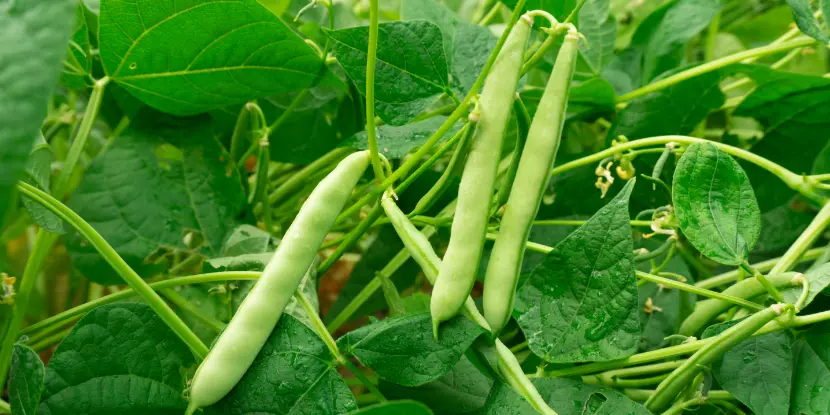
Green beans will yield multiple harvests in a season.
5. Zucchini & Summer Squash
These prolific plants can start producing within a month and continue until the first frost. Zucchini is a favorite in Italian cuisine — it even has an Italian name!
- Best Varieties: Black Beauty zucchini, Crookneck squash, Yellow Straightneck squash.
- Planting Tips: Sow seeds directly in well-drained soil after all danger of frost has passed. Provide support for vines to climb.
- Climate Suitability: Prefers warm weather and full sun.
- Time to Harvest: 4–8 weeks for first harvest, then continuous production until frost.
- Special Notes: Pick zucchini and squash when young and tender, about 6–8 inches long.
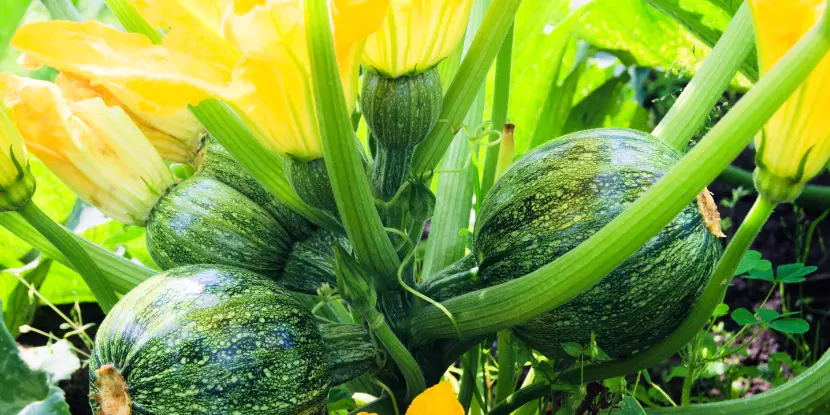
Young zucchini fruit on the plant, some still attached to their blooms.
6. Green Onions (Scallions)
Green onions act as natural pest repellents for other plants in your garden.
- Best Varieties: Evergreen Hardy White, Tokyo Long White.
- Planting Tips: Sow seeds directly in well-drained soil and keep them moist until germination. Thin seedlings to 3–4 inches apart.
- Climate Suitability: Adapts to a wide range of temperatures but prefers mild weather.
- Time to Harvest: 3–4 weeks.
- Special Notes: Harvest green onions as needed by cutting the tops, allowing for continuous growth.
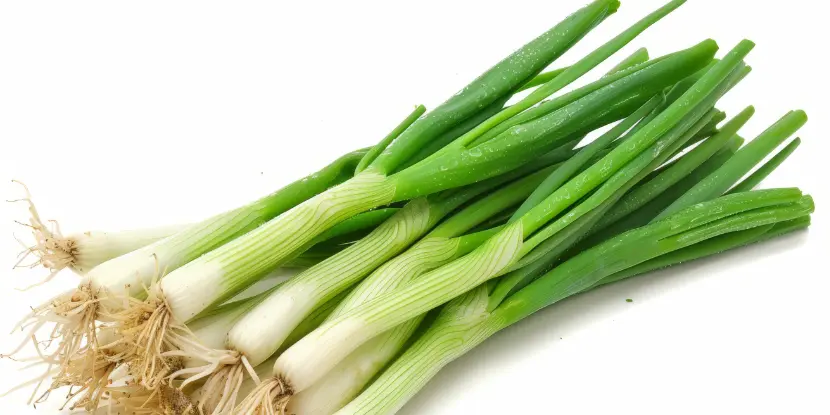
Green onions have pest repellent properties. More for your plate!
7. Beets
Beets are low maintenance and can be grown for their greens and roots.
- Best Varieties: Early Wonder, Detroit Dark Red.
- Planting Tips: Sow seeds directly in well-drained soil about an inch deep and two inches apart. Thin seedlings to 2–3 inches apart once they’ve germinated.
- Climate Suitability: Prefers cool weather but can tolerate some warmth.
- Time to Harvest: 6–8 weeks for greens, 8–10 weeks for roots.
- Special Notes: Harvest beet greens young and tender, about 2–3 inches. Leave space between plants for root growth.
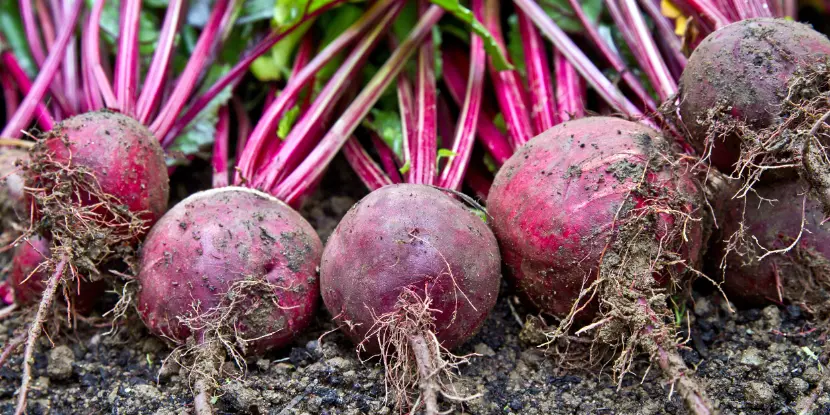
Beets were first cultivated for their greens, not their roots.
8. Bok Choy
Bok choy, or Chinese cabbage, matures swiftly and is well-suited to the Southern California climate.
- Best Varieties: Baby Bok Choy, Joi Choi.
- Planting Tips: Sow seeds in rich, well-drained soil in a location with full to partial sun. Space plants about 6 inches apart.
- Climate Suitability: Prefers cooler temperatures but can tolerate some heat.
- Time to Harvest: 4–6 weeks.
- Special Notes: Ideal for stir-fries and soups; harvest the entire plant or just the outer leaves as needed.
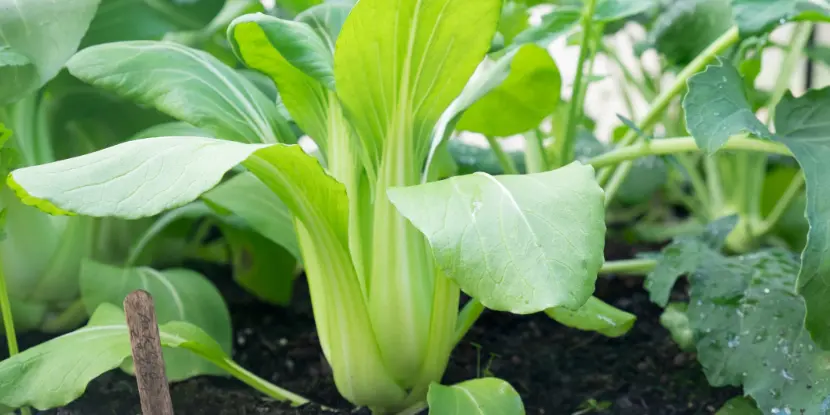
Bok choy is one of the fastest growing vegetables and can be harvested at almost any point in its development.
9. Carrots
Carrots can be ready to harvest in just over two months. Juice or soup? Your choice.
- Best Varieties: Nantes, Danvers, Scarlet Nantes.
- Planting Tips: Sow seeds directly in loose soil about ½ inch deep. Keep moist during germination.
- Climate Suitability: Prefers cooler weather and full sun but can tolerate some heat.
- Time to Harvest: 60–80 days. When ready, look for the tops of the carrots to push out of the soil.
- Special Notes: Once they’ve germinated, thin seedlings to 1–2 inches apart. Carrots can be left in the ground for extended periods without losing quality.
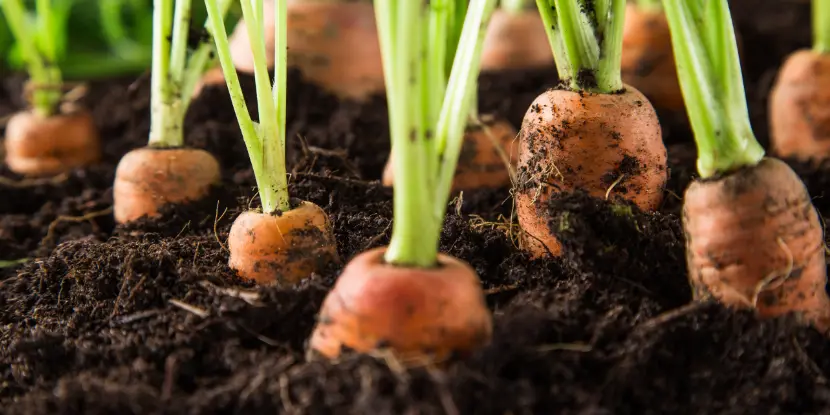
Carrots are ready for harvest when their roots push through the soil.
10. Swiss Chard
Swiss chard is a colorful, nutritious green that’s easy to grow and quick to mature.
- Best Varieties: Bright Lights, Fordhook Giant.
- Planting Tips: Sow seeds directly in well-drained soil about an inch deep and two inches apart. Once they’ve germinated, thin seedlings to 4–6 inches apart.
- Climate Suitability: Prefers cooler weather but can tolerate some heat.
- Time to Harvest: 30–60 days for baby greens, 60–80 days for full-size leaves.
- Special Notes: Pick outer leaves as needed, and the plant will continue to produce. It can also be grown in containers.
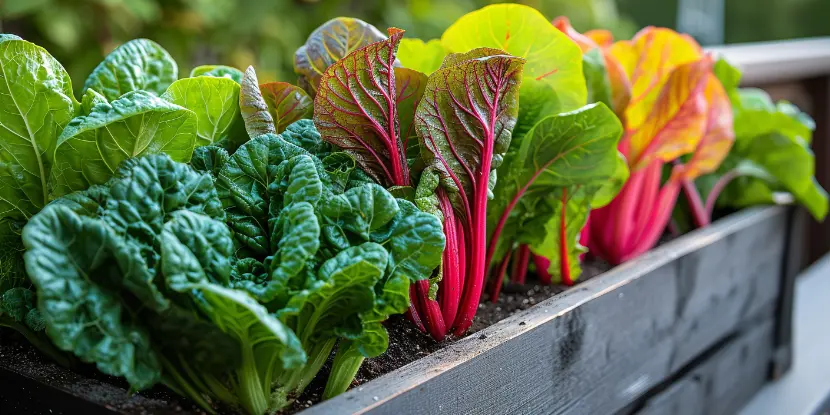
Fast-growing Swiss chard is almost too pretty to pick.
11. Peppers
Peppers require more patience than other vegetables, but their flavor is worth the wait.
- Best Varieties: Bell peppers, Jalapeño, Anaheim.
- Planting Tips: Sow seeds indoors about 8 weeks before the last expected frost. Transplant outdoors once the soil has warmed and all danger of frost has passed.
- Climate Suitability: Thrives in warm weather and full sun.
- Time to Harvest: 60–90 days, depending on variety.
- Special Notes: Peppers can be picked green or left to ripen to their final color. Cut rather than pull peppers from the plant to avoid damaging the stem.
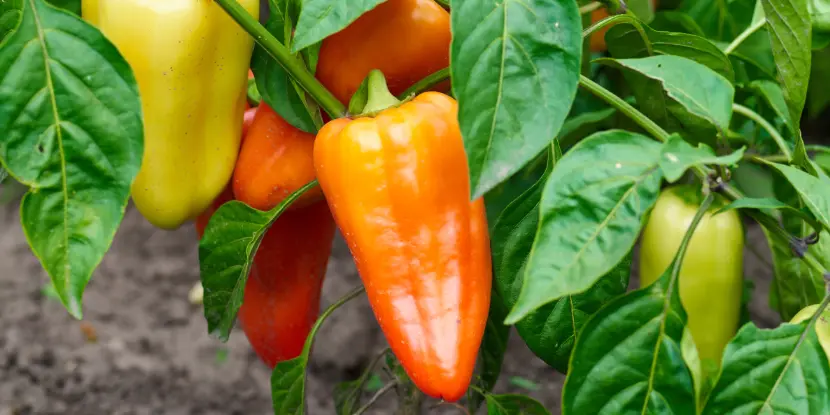
The longer peppers remain on the plant, the sweeter they grow.
12. Turnips
Turnips offer the bonus of edible greens and roots.
- Best Varieties: Purple Top White Globe, Tokyo Cross
- Planting Tips: Sow seeds directly in well-drained soil, spacing them about 2–4 inches apart. Ensure even soil moisture throughout growth.
- Climate Suitability: Prefers cooler temperatures, suitable for fall or early spring planting
- Time to Harvest: 6–8 weeks
- Special Notes: Harvest greens as they grow and pull up the roots when they reach the desired size.
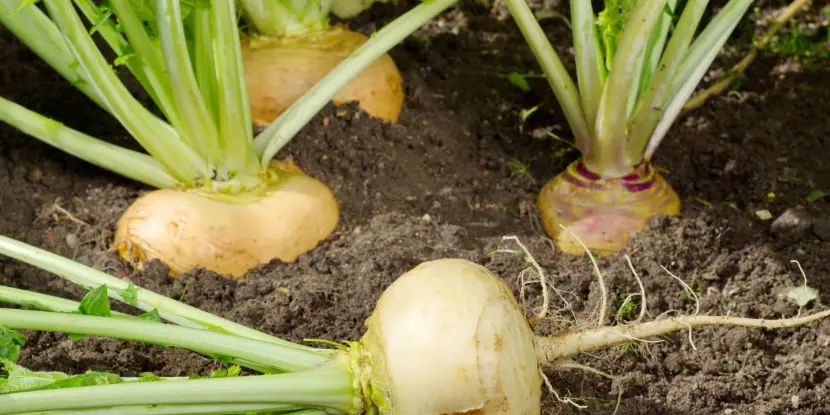
Turnips, anyone? The roots and foliage are edible.
Tips for a Bountiful Garden
1. Enrich Your Soil
Healthy soil is the foundation of a healthy garden. Southern California soils can be sandy and lacking in nutrients, so amend your soil with compost and organic matter. Heavy clay soils should be loosened and mixed with compost to improve drainage.
2. Plant at the Right Time
Pay attention to planting schedules and recommended growing seasons for each vegetable. Southern California’s mild climate allows for year-round gardening, but some vegetables prefer cooler temperatures while others thrive in warmth.
3. Water Wisely
With the region’s semi-arid climate, efficient watering is crucial. Consider installing drip irrigation or soaker hoses to deliver water directly to the roots while minimizing evaporation. Mulching can also help retain moisture in the soil.
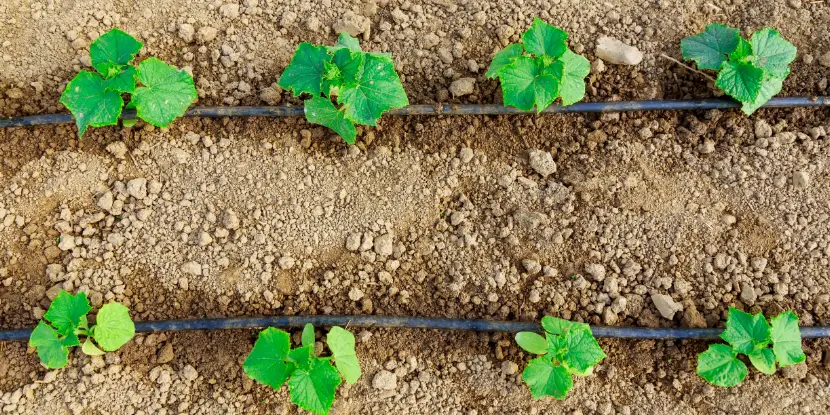
Drip irrigation delivers water directly to a plant’s roots.
4. Protect from Pests
Integrate pest control measures into your gardening routine to prevent damage and loss of crops. Planting diverse varieties and using natural pest repellents, like companion planting or beneficial insects, can help protect your garden.
5. Rotate Crops
Avoid planting the same vegetables in the same place each year to prevent nutrient depletion and buildup of pests and diseases. A crop rotation plan can also help optimize space and maximize yields.
6. Harvest Regularly
Harvest vegetables at their peak for the best flavor and nutrition. Leaving vegetables on the plant for too long can make them tough or bitter.
FAQs: Cultivating Fast-Growing Vegetables
Q: Can I grow fast-growing vegetables in containers?
Many fast-growing vegetables do well in containers. Pots should have good drainage and use high-quality potting soil. Radishes, lettuce, and spinach are particularly well-suited for container gardening.
Q: How can I speed up the growth of my vegetables?
Ensure your plants get adequate sunlight, water, and nutrients. Regularly amend the soil with compost, keep it consistently moist, and consider using organic fertilizers. Also, choosing the right varieties for your climate will naturally lead to faster growth.
Q: What are the signs that my vegetables are ready to harvest?
Each vegetable has its indicators. Radishes should be harvested when they’re about an inch in diameter. Lettuce and spinach can be picked as baby greens or allowed to mature. Green beans are ready when they’re firm and crisp, and zucchini should be harvested when they’re 6-8 inches long.
Q: Can I cultivate fast-growing vegetables indoors?
Yes, if you have sufficient light. Use grow lights to provide the necessary light spectrum and intensity. Herbs, lettuce, radishes, and baby spinach are excellent choices for indoor gardening.
Q: How often should I fertilize my fast-growing vegetables?
It depends on the type of vegetable and the quality of your soil. As a general rule of thumb, apply a balanced organic fertilizer every 4-6 weeks. Follow the recommendations for each vegetable type and monitor plant health to adjust as needed.
Q: What are common pests to watch for with fast-growing vegetables?
Common pests include aphids, slugs, snails, and caterpillars. Good garden hygiene, such as cleaning up debris and not overwatering, can reduce pest problems. Natural predators like ladybugs and organic pest repellents can also control these pests.
Q: Are there any fast-growing root vegetables suitable for beginners?
Radishes and turnips are excellent choices for novice gardeners. They germinate quickly and require minimal maintenance.
Carrots can also be grown quickly, but they require loose soil for their roots to grow.
Q: What vegetables are best for small gardens?
Many fast-growing vegetables are suitable for smaller gardens. Lettuce, spinach, radishes, and green beans take up little space and can even be grown in containers. Tomatoes, peppers, and eggplants can be grown vertically on trellises or cages to save space.
Q: Can I interplant fast-growing vegetables with other plants?
Yes, this is known as companion planting. Certain combinations can benefit each other by providing nutrients or repelling pests. For example, planting carrots with rosemary can ward off carrot flies. Do some research to find the best companion plants for your vegetables.
Q: How do I know if my fast-growing vegetables get enough water?
Check the soil moisture about 2 inches down from the surface. If it feels dry, it’s time to water. Wilting or yellowing leaves can also indicate a lack of water. Avoid overwatering, which can cause root rot and other issues.
Q: Can I grow fast-growing vegetables in raised beds?
Raised beds offer many benefits, including faster growth due to warmer soil temperatures. They also provide better control of soil quality and drainage. Just be sure to regularly amend the soil with compost to keep it nutrient-rich. Overall, raised beds can maximize yields and make gardening more efficient.

